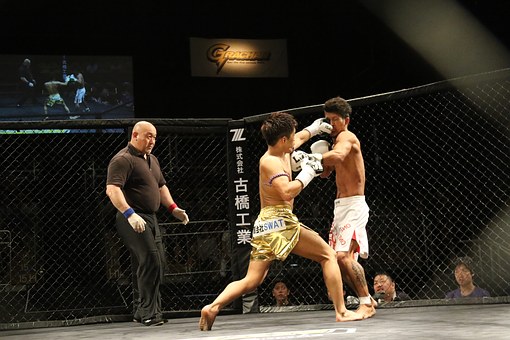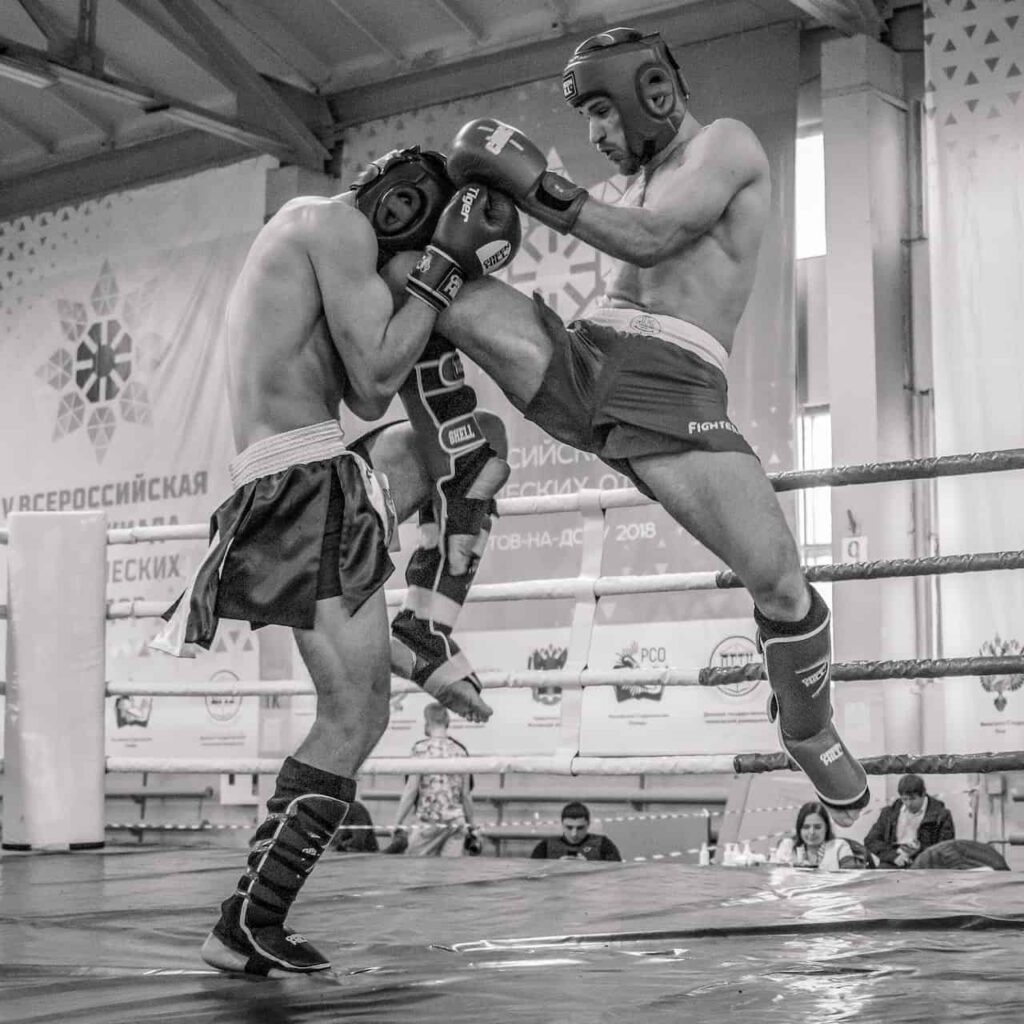Which are the main differences in fighting techniques as well as competition rules and fighting philosophy when it comes to Savate vs Kickboxing?
This post will also look at the techniques and fighting strategies and philosophies of these two distinct striking arts.
As well as these styles origins, both cultural and geographical, which led to their unique characteristics.
The most obvious differences between Savate vs Kickboxing are the use of shoes in Savate, while Kickboxing is fought barefoot as well as the use of knees in Kickboxing, while Savate focuses on punches and kicks.
But in this post we go in depth on more of the major differences between these two styles.
Savate: A Brief History
Savate, often referred to as “La Boxe Française,” is a unique and elegant French fighting system that fuses together elements of both traditional boxing and kicking techniques.
Renowned for its emphasis on footwork, precision, and style, Savate has earned a special place in the world of martial arts as a sport that beautifully combines practical combat techniques with a touch of artistic flair.
The history of Savate traces back to the early 19th century in the bustling streets of France, where self-defense and brawls were common occurrences.
It is believed that the roots of Savate can be found in the various regional fighting styles practiced by sailors, street fighters, and working-class individuals in different parts of France.

These distinct martial traditions eventually merged and evolved into a cohesive system, with its own set of rules and techniques.
One of the key figures credited with formalizing and popularizing Savate was Michel Casseux, a French street fighter and former sailor, who earned the title of “Father of Savate.”
In the early 1800s, Casseux developed a method of using kicks in combination with hand strikes, creating a more refined and systematic approach to the art of kicking and punching.
He began teaching this new fighting style to the public, which eventually led to the establishment of dedicated Savate training centers.
Kickboxing: History and Development
Kickboxing can generally be divided into two distinct styles, mainly Japanese Kickboxing and American Kickboxing.
Japanese Kickboxing
Japanese Kickboxing originated from the Muay Thai vs Karate match ups that took place in the 1960’s and 70’s and the eventual fusion of these two styles and combination with Western boxing which led to the sport we now know as Kickboxing.
In fact the modern day term ‘kickboxing’ is said to have originated form Japanese Kickboxing.

Japanese Kickboxing and specifically the Mejiro Gym was also the foundaiton for the later development of the Dutch style kickboxing which is world recognised today with famous fighters such as Alistair OVereem and Nicky HOlzkien to name just a couple.
American Kickboxing
American kickboxing is thought to have developed from the influence of point scoring and full contact Karate tournaments in the US dating back to the 70s and 80s.
From the wide use of spinning type kicks and attacks in American kickboxing, Taekwondo is also seen as a contributing style in American kickboxing.
A major contributing factor the development of American kickboxing is thought to be the popularity of full-contact Karate tournaments in the United States during the 70s and 80s.
Main Differences: Savate vs Kickboxing
As unique and distinct striking styles the main differences between Savate and Kickboxing include:
Origin and History
Savate originated in France during the early 19th century and evolved from various regional fighting styles practiced by sailors and street fighters.
It incorporates elements of Western boxing and kicking techniques.
Kickboxing emerged in Japan during the 1960s and 1970s, blending traditional Muay Thai kickboxing with karate and other martial arts.
It was later popularized in the United States and other parts of the world including the Netherlands where the distinct style of Dutch kickboxing was born
Use of Shoes in Fighting
Unlike Savate, which requires specific shoes, kickboxing is often practiced barefoot.
However, in some specific styles or competitions, foot protection may be allowed or required depending on the kickboxing organizaitons rules set.
But shoes are a critical part of Savate.
In Savate, practitioners wear specialized shoes known as “savate shoes” or “savate boots.”
These shoes are specifically designed to enhance the performance of kicking techniques while providing support and protection to the foot and ankle.
The toe area of Savate shoes is often reinforced with extra padding or a protective layer. This reinforcement helps prevent injuries to the toes when delivering powerful kicks to an opponent’s body or head.
Kicking Techniques
Savate is renowned for its elegant and diverse kicking techniques.
Kicks in Savate are executed with the ball of the foot and the instep, emphasizing precision and speed.
Savate includes a range of kicks such as the chassé (front kick), fouetté (roundhouse kick), and coup de pied bas (low kick).
While kickboxing also includes kicking techniques, they are often more simplified compared to Savate.
Kickboxing kicks commonly include the roundhouse kick (basically the muay thai roundhouse which strikes with the shin) and the push kick, and they are delivered with the shin or the foot.
Spinning style kicks are also used in Kickboxing and can be traced back to origins in Karate and Taekwondo.
Philosophy and Aesthetics
Savate places a strong emphasis on elegance, style, and artistic expression.
It is often seen as a martial art that combines combat effectiveness with beauty in movement.
In kickboxing, most styles do focus on clean and powerful techniques, the aesthetic aspect is not as central to the philosophy of kickboxing as it is to Savate.
Competition Rules
Savate competitions are governed by the International Savate Federation (FISav) and have specific rules regarding legal techniques, scoring, and protective equipment.
Points are awarded for clean techniques delivered to specific target areas.
Kickboxing competitions may have different rule sets depending on the organization and the specific style of kickboxing (e.g., K-1 rules, Muay Thai rules).
Scoring criteria, allowed techniques, and protective gear requirements can also vary across different organizations.
Knee Strikes
Knee strikes are a big part of kickboxing, owing to the influence form traditional styles like Muay Thai.

However in Savate, knees are not traditionally taught and trained as part of Savate.
Also in competitions in Savate knees are not allowed and the focus is on punches and kicks.
However self defense focussed Savate does include the use of knees.
Fight Gear
In Savate, competitors typically wear a form-fitting, sleeveless jersey that covers the upper body.
The jersey is designed to allow ease of movement and is often made of lightweight and breathable material.
While in Kickboxing fights usually take place with both fighters bare-chested for males.
Footwork and Movement
Savate places a strong emphasis on footwork, lateral movement, and agile positioning.
It emphasizes maintaining the right distance from the opponent to optimize kicking range.
While footwork is important in kickboxing as well, it may not be as pronounced or as much of a defining characteristic as in Savate.
Savate vs Kickboxing: Wrap Up
While both Savate and Kickboxing focus primarily on combat using punching and kicking striking techniques there are key differences between the styles.
These have been discussed above and the key differences include:
- use of shoes in fighitng
- use of knee strikes
- kicking techniques
- difference in competition rules which include fighting gear
- emphasis on aesthetics and beautiful techniques in Savate which is not so central to Kickboxing philosophy of fighting
These differences can be attributed to the cultural and geographical origins of these two styles, with French culture and Asian/American cultural influences as well as blending of different styles of fighting systems into the formation of these two styles.



